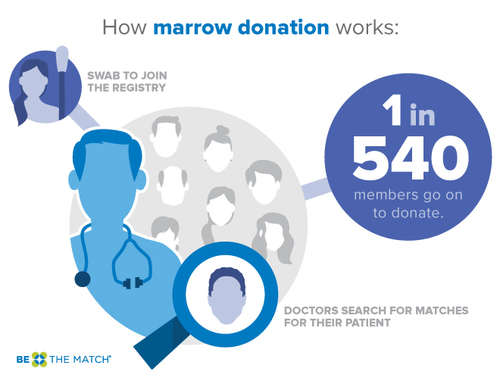This year, over 14,000 patients will request a bone marrow transplant that will never arrive.
Part of the problem is undoubtedly the fact that only 3% of Americans are signed up as marrow donors. But what else prevents patients in need of bone marrow transplants from receiving them?
I sat down and interviewed Michael Boo, J.D. from “Be The Match” to learn more about the ins and outs of bone marrow transplants. Why do only 35% of patients requesting a transplant receive one? How important is the speed with which bone and blood cancers are treated? What can we do to help?
What are the barriers to bone marrow transplants?
Michael: Historically, finding a match was the main barrier. However, today access is more likely to be limited by lack of insurance coverage or inadequate insurance coverage. Additional barriers to transplant include lack of access to a transplant center, lack of timely referral for transplant, and decline in health status. Be The Match is addressing these barriers by working with medical professionals and insurance companies to assure timely referrals and adequate coverage and continues to grow and diversify the Be The Match Registry, to ensure that all patients have access to this therapy.
What are the typical or average costs associated with blood stem cell transplants, what is included in those costs and how are these costs covered?
Michael: An unrelated transplant is an expensive procedure. The average billed charges can run $500,000 and up, and includes a number of costs from hospital stays to post-transplant drug regimens. Insurance companies do not pay Be The Match directly – they pay for these services through the transplant centers as part of their contracted rates for a transplant procedure. The cost for finding a donor and getting the cells varies based on patient and where the cells are coming from, but average costs can be found in a series of documents we have on our payor website.
The costs that may not be covered by insurance are 1) testing potential donors or family members to find a match, 2) travel and lodging while undergoing transplant and recovery – many patients need to be away from home for up to 100 days and their transplant centers are often located far from home, 3) prescription medications for post-transplant care, and 4) other miscellaneous costs specific to creating a home environment that’s safe after transplant – carpet cleaning, etc. Be The Match has a Patient Assistance Program, which grants an average of $2.5 million per year, funded by Be the Match Foundation to help with these additional costs.
What methodology was used to determine a 1 in 540 chance of being called on to donate?
Michael: The likelihood of being called as a potential match is based on the number of searches or transplants over a five year period and the size of the registry – X number of searches or donations per Y number of people on the registry. It is not an annual number (i.e. the likelihood of being called in a given year.) This represents a general likelihood of being called or donating at this point in time. Likelihood changes over time with increases to the number of registry members and number of transplants using domestic donors. This does not account for other factors that influence likelihood of donating including HLA type, sex, age, race, donor center, time on the registry, etc.
Thanks Michael! Anything else people should know?
Michael: No problem. People with additional questions should read Be The Match’s FAQ. And if they want to help save a life, they should sign up to join the national bone marrow registry.








